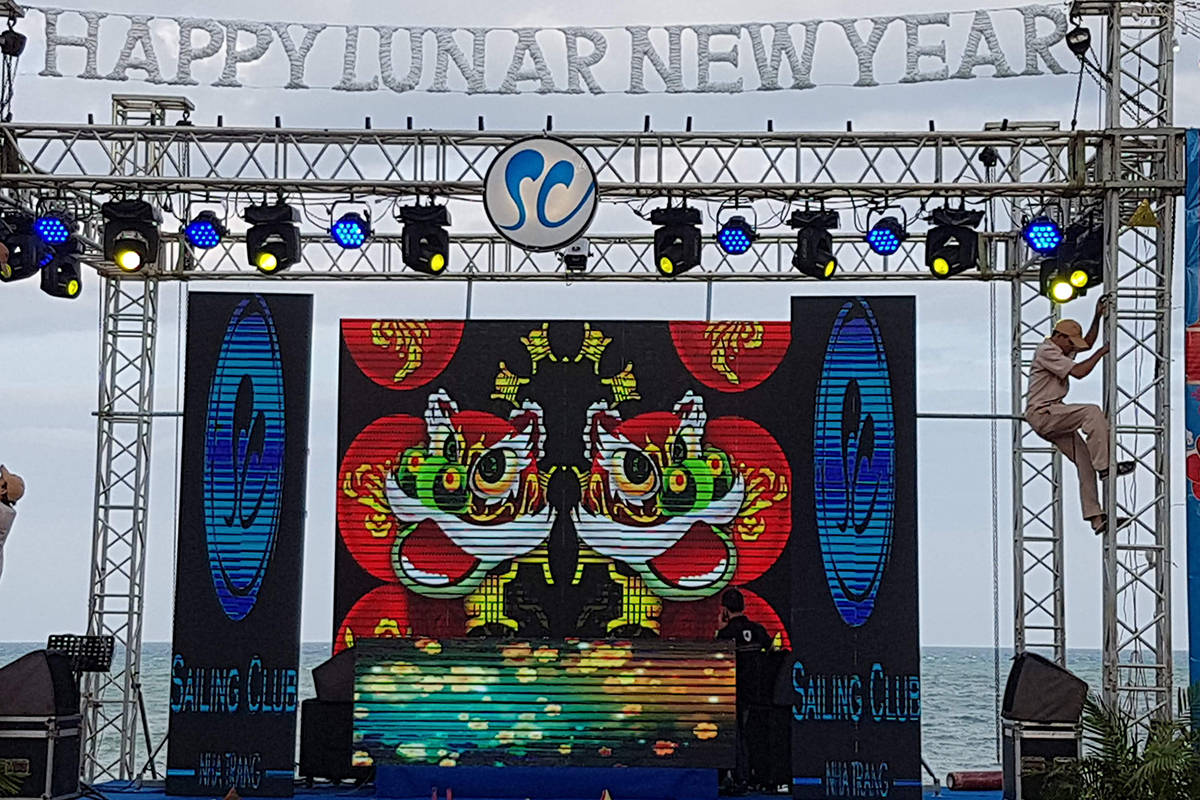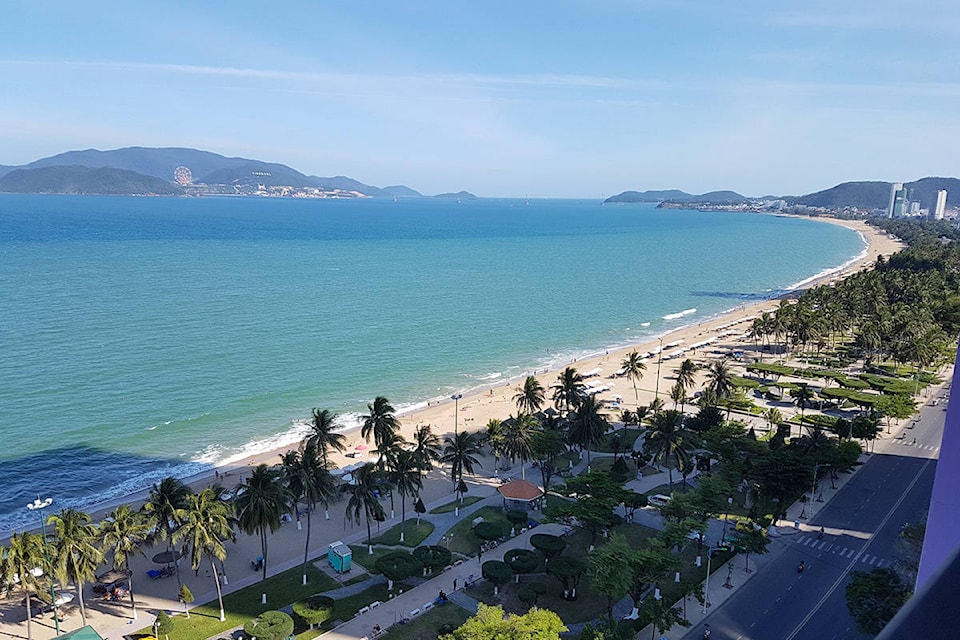Ron England
Observer Contributor
Midnight, Feb. 4.
Loud, booming sounds disturb our deep sleep. We both stumble out to our 12th-storey hotel balcony. Thousands of locals on motorcycles have completely filled the four-lane beach roadway for blocks. The attraction and noise? Massive launchers across the street in the beach square are hurtling their fireworks skyward the show continues for a full 30 minutes. It’s the opening round of the 2019 Tet Lunar New Year celebrations.
Welcome to Nha Trang, Vietnam!
After spending five steamy days in Siem Reap, Cambodia, we have made our way to Vietnam’s largest beach community, Nha Trang. The city of about 500,000 is located on Nha Trang Bay, voted one of the top 30 bays in the world. Turquoise clean waters form the backdrop of the main beach in the downtown core tourist area. Careful planning of beach-front development has created a landscaped promenade buffer zone between the sand and the hotels located across a busy four-lane road.
READ MORE: Englands in China: Quesnel couple experiences typhoon in Foshan
The white sand and warm tropical waters are the draw for the tourist trade in the area. The downtown core strip has been fully developed with hotels and restaurants; however, new resorts are under construction along Cam Rahn Bay (next door to Nha Trang) and the south eastern shores of Nha Trang Bay.
Upon arriving in Nha Trang, one might wonder if they were in Russia or Vietnam! Many signs on the storefronts along the beach strip are written in Cyrillic (the Russian alphabet), including pharmacies, tour offices, restaurants, and convenience stores. And most restaurant menus are in Vietnamese, English and Russian as well.
What accounts for the large numbers of Russian tourists?
After North and South Vietnam were reunited in 1975, the Pacific fleet of the Soviet Navy secured a lease for the warm, deep water anchorage of Cam Rahn Bay. In 2002 the Vietnamese regained possession. Nha Trang beaches had become very popular with Russian sailors and their families, so much so, that a thriving expat community was established.
With travel restrictions lifted after the collapse of the Soviet Union, Nha Trang became the destination of Russians escaping the bitter Motherland winter. Yet, the recent decline of the Russian ruble has caused a slight dip in numbers; Chinese tourists now outnumber their Russian counterparts.
Stereotyping appears to have become almost a pastime in many travellers’ blogs and reviews posted on booking websites. All too often, Russian tourists have been labelled as rude, belligerent, or sullen. Our experience in Nha Trang (and Phu Quoc) was just the opposite. Most Russian couples and families we met were friendly, polite and engaging. I suppose it’s easy to find fault with any nationality if you look hard enough!
We are walkers and beach people.
We had little interest in exploring yet another temple or pagoda. After spending nearly two weeks planted under a thatched roof gazebo just steps away from the surf I came to realize the Nha Trang beach culture has a repeated rhythm.
Six a.m. finds the locals walking the beach or swimming in the early morning calm waters. Many seniors gather for a form of yoga in the many squares along the promenade or are to be found exercising on the many pieces of equipment along the boulevard. By 9 a.m. the locals have departed, leaving the blazing heat of the day to the tourists. By 10 a.m. the hundreds of loungers parked under a tent city of umbrellas are occupied by Western Europeans and North Americans. And, let’s not forget, Russians!
At about noon, Korean and Japanese visitors (many dressed for winter, I might add) disembark from their tour buses. After dipping their feet in the warm surf and taking what seems like a dozen selfies, they are gone, retreating to the cooler climes of the shopping malls.
By late afternoon the local Vietnamese are back; small food stands appear on the walkways offering up roasted corn, yams, spiny lobsters, baby squid, traditional Vietnamese pancakes and a variety of meat skewers. Just before twilight, the local beach crowd returns; many for a refreshing dip, others sitting on towels for family picnics. And so it goes, day after day after day…
We did undertake one “adventure” in Nha Trang: a visit to a market to purchase prawns and vegetables for a home-cooked stir fry. Our condo host, Mrs. Huong recommended a small market only a few blocks from our condo.
In my infinite wisdom, I chose to disregard her advice and insisted we go to the much larger Dam Market, a good distance by taxi. What a mistake!
After navigating through the building housing hundreds of stalls selling overpriced tourist kitsch, we made our way, following our noses, to the open air meat and produce section. The smell of rotting produce mixed together with seafood innards and blood was overpowering.
We, quite literally, were walking ankle deep in rotting fruit and vegetable trimmings or fish offal that were simply dumped onto the pavement. We did find our sought-after prawn — laying in warm water tubs, not a spec of ice to be seen.
READ MORE: Englands in Asia: exploring Cambodia
We have visited numerous local markets in our travels in China, Cambodia and Vietnam, and this one was easily the filthiest mess we have been to. Swallowing my pride, I agreed with Gill and Mike that we should grab a taxi and go to the smaller market originally suggested.
The second market was certainly much cleaner. All the seafood was laid out on beds of ice. The fish monger made sure to include a good quantity of crushed ice in our bag of prawns. Lesson learned: follow the advice of the locals.
Interestingly enough, fruit and vegetables are not priced individually by variety. You simply place all your selections in a basket which is then weighed and sold by the kilogram. What a novel idea!
Thursday, Feb. 14, we arrived in Hanoi International Airport. After a short hop from Nha Trang, we were at our boarding gate for the next short hop up to Guangzhou, China.
Gill pulls a 500ml bottle of water from her purse. She had purchased it after security in Nha Trang.
“So much for security at this airport,” she comments. She is somewhat concerned with this security breach, but I’m now focused on the Foshan-Guangzhou weather forecast I have pulled up on my laptop.
“Looks like we are in for a cold snap, Gill. The high this afternoon in Foshan is only going to reach 20 degrees!”

